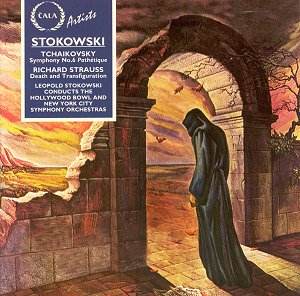 Composer: Leopold Stokowski
Composer: Leopold Stokowski
Works: Tchaikovsky: Symphony No. 6 “Pathétique”; Strauss: Tod und Verklärung
Performers: Hollywood Bowl Symphony Orchestra, New York City Symphony Orchestra
Recording: July 1945 (Tchaikovsky), December 1944 (Strauss)
Label: Cala CACD 0506
Leopold Stokowski, a conductor synonymous with flamboyant orchestral color and innovative interpretation, remains a pivotal figure in the annals of recorded classical music. His interpretations of Tchaikovsky and Strauss exemplify his unique approach to orchestral sound, blending rich tonal palettes with an often contentious relationship to the structural integrity of the works he conducted. This disc, comprising Stokowski’s recordings of Tchaikovsky’s “Pathétique” Symphony and Strauss’s “Tod und Verklärung,” underscores both his artistic vision and the complexities inherent in these compositions.
The “Pathétique,” Tchaikovsky’s final symphonic utterance, is a work steeped in emotional depth and tragic narrative. Stokowski’s interpretation, recorded in the summer of 1945 with the Hollywood Bowl Symphony Orchestra, is charged with an intense emotionalism that is characteristic of his style. However, this performance often teeters on the edge of excess. The lush string textures and expansive phrasing are exhilarating yet can lead to interpretive shortcomings. For instance, the climaxes—particularly in the third movement—lack the taut architectural build that can transform tension into catharsis. Instead, they emerge as disjointed peaks, reflecting Stokowski’s penchant for emotional immediacy over structural clarity. This passion, while magnetically engaging, can also risk becoming coagulatory, as noted in the recording’s heavier moments where sentimentality threatens to overshadow the symphonic discourse.
Turning to Strauss’s “Tod und Verklärung,” recorded with the New York City Symphony Orchestra, the contrast in interpretive philosophy becomes apparent. Here, Stokowski’s orchestral coloring reigns supreme, with a vibrant orchestral palette that transforms the score into a vivid sonic landscape. The opening, marked by intricate woodwind lines and surging strings, showcases Stokowski’s deft manipulation of timbre, creating a visceral experience. However, the overall architecture suffers from an imbalance; the emotional peaks are exhilarating yet often feel isolated rather than integrated into the larger structure. The interplay between the thematic material lacks the seamless flow found in more disciplined interpretations, such as those by Mengelberg, whose readings juxtapose Stokowski’s fluidity with a more restrained, yet impactful, narrative arc.
The recording quality, typical of the mid-1940s, presents its own challenges. While the engineering captures the vibrancy of Stokowski’s orchestral forces, it can also obscure finer details within the orchestral fabric. Certain passages, particularly in the brass, exhibit a tendency toward muddiness, which detracts from the clarity of the intricate counterpoint that defines Strauss’s work. This contrasts sharply with contemporary recordings that benefit from advanced engineering techniques, allowing for a more transparent and nuanced listening experience.
Comparative analysis reveals that Stokowski’s interpretations, while undeniably compelling, often lack the structural and emotional coherence found in other notable recordings of the time. His 1973 traversal of the “Pathétique” with the London Symphony Orchestra, for instance, provides a more balanced view of Tchaikovsky’s emotional trajectory, presenting a clearer narrative arc that eludes the 1945 performance. Similarly, Strauss’s “Tod und Verklärung” has been rendered with greater architectural integrity in recordings by conductors like Karajan, whose interpretations successfully marry emotional intensity with formal cohesion.
The recordings of Stokowski in this compilation highlight both the strengths and weaknesses of his interpretative style. His vibrant orchestral colors and emotional immediacy are undeniably captivating, yet they often come at the cost of structural clarity and compositional integrity. For listeners drawn to the visceral and the expressive, these performances will resonate deeply, but they may leave purists yearning for a more disciplined approach to the intricate architectures of Tchaikovsky and Strauss. The essence of Stokowski’s artistry lies in his ability to evoke profound emotion, and while this disc offers a compelling glimpse into his interpretative world, it also serves as a reminder of the delicate balance between emotional expression and structural coherence in orchestral performance.



